Sustainability and the Environment: Case Study Analysis
VerifiedAdded on 2022/10/08
|22
|5505
|47
Report
AI Summary
This report presents a comprehensive analysis of environmental sustainability, focusing on three key case studies: climate change in the Magway region of Myanmar, soil pollution in Youxian, China, and air pollution in Jaipur and Delhi, India. The report delves into the current environmental issues, identifies the causes of these problems, and assesses their impacts on the environment, population, and sustainable development. It explores the specific challenges faced in each region, such as increased flooding and erratic rainfall in Myanmar, industrial pollution and agricultural practices in China, and air quality deterioration in India. Furthermore, the report proposes potential solutions and action plans to mitigate these environmental issues, including government interventions, international collaborations, and community-based initiatives. The analysis highlights the need for immediate action to address the dangers of climate change, soil degradation, and air pollution to ensure a sustainable future for all.
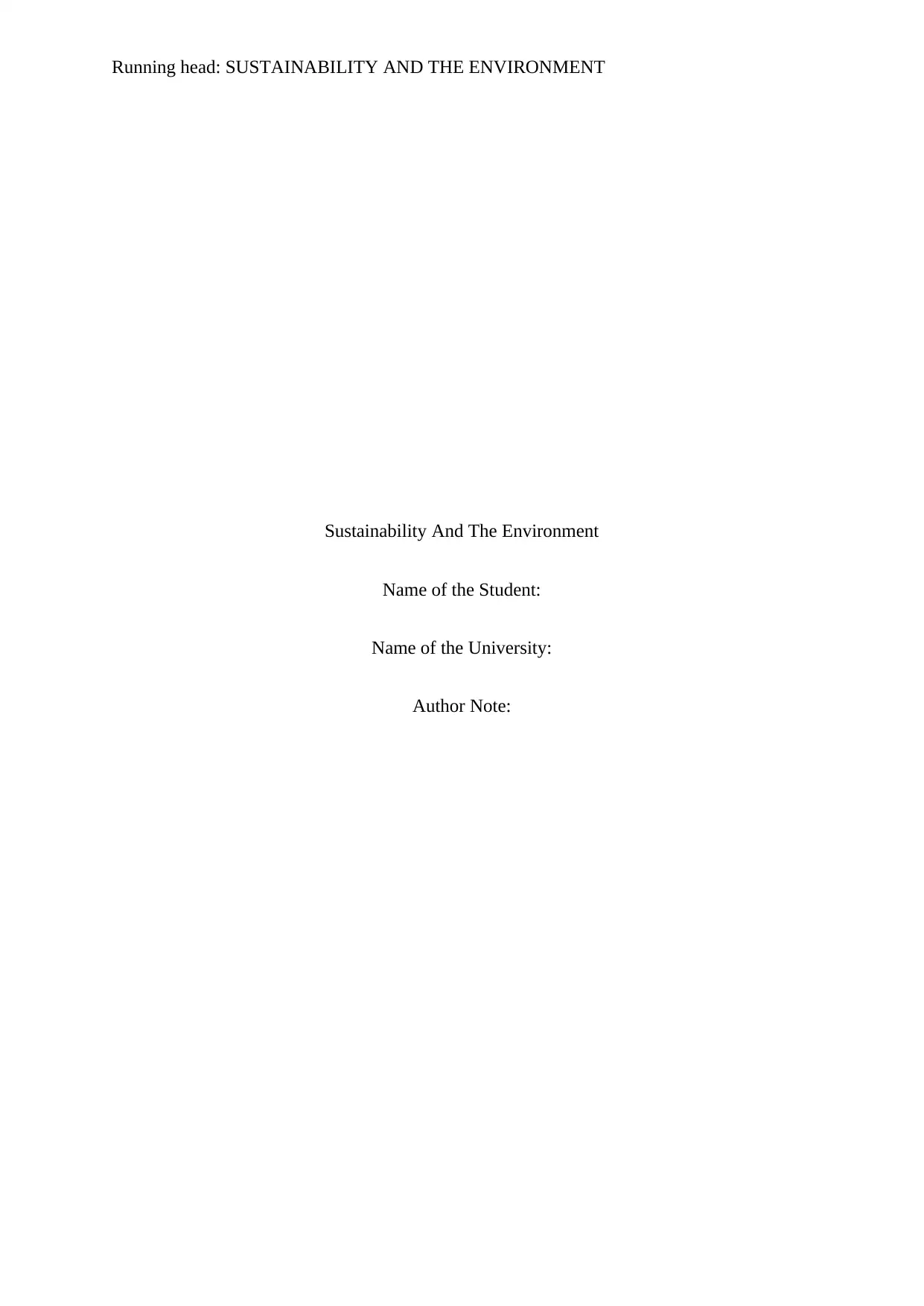
Running head: SUSTAINABILITY AND THE ENVIRONMENT
Sustainability And The Environment
Name of the Student:
Name of the University:
Author Note:
Sustainability And The Environment
Name of the Student:
Name of the University:
Author Note:
Paraphrase This Document
Need a fresh take? Get an instant paraphrase of this document with our AI Paraphraser
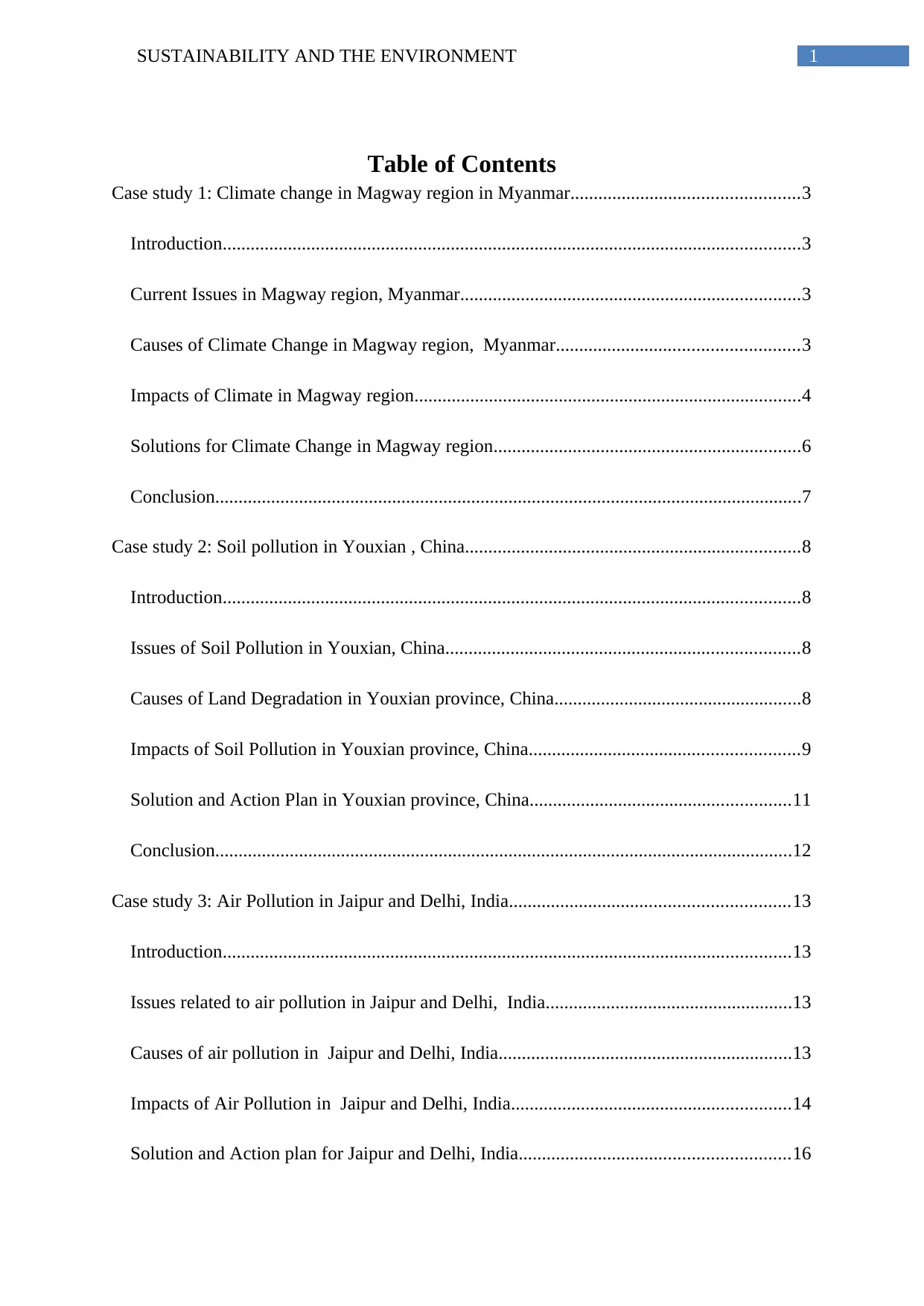
1SUSTAINABILITY AND THE ENVIRONMENT
Table of Contents
Case study 1: Climate change in Magway region in Myanmar.................................................3
Introduction............................................................................................................................3
Current Issues in Magway region, Myanmar.........................................................................3
Causes of Climate Change in Magway region, Myanmar....................................................3
Impacts of Climate in Magway region...................................................................................4
Solutions for Climate Change in Magway region..................................................................6
Conclusion..............................................................................................................................7
Case study 2: Soil pollution in Youxian , China........................................................................8
Introduction............................................................................................................................8
Issues of Soil Pollution in Youxian, China............................................................................8
Causes of Land Degradation in Youxian province, China.....................................................8
Impacts of Soil Pollution in Youxian province, China..........................................................9
Solution and Action Plan in Youxian province, China........................................................11
Conclusion............................................................................................................................12
Case study 3: Air Pollution in Jaipur and Delhi, India............................................................13
Introduction..........................................................................................................................13
Issues related to air pollution in Jaipur and Delhi, India.....................................................13
Causes of air pollution in Jaipur and Delhi, India...............................................................13
Impacts of Air Pollution in Jaipur and Delhi, India............................................................14
Solution and Action plan for Jaipur and Delhi, India..........................................................16
Table of Contents
Case study 1: Climate change in Magway region in Myanmar.................................................3
Introduction............................................................................................................................3
Current Issues in Magway region, Myanmar.........................................................................3
Causes of Climate Change in Magway region, Myanmar....................................................3
Impacts of Climate in Magway region...................................................................................4
Solutions for Climate Change in Magway region..................................................................6
Conclusion..............................................................................................................................7
Case study 2: Soil pollution in Youxian , China........................................................................8
Introduction............................................................................................................................8
Issues of Soil Pollution in Youxian, China............................................................................8
Causes of Land Degradation in Youxian province, China.....................................................8
Impacts of Soil Pollution in Youxian province, China..........................................................9
Solution and Action Plan in Youxian province, China........................................................11
Conclusion............................................................................................................................12
Case study 3: Air Pollution in Jaipur and Delhi, India............................................................13
Introduction..........................................................................................................................13
Issues related to air pollution in Jaipur and Delhi, India.....................................................13
Causes of air pollution in Jaipur and Delhi, India...............................................................13
Impacts of Air Pollution in Jaipur and Delhi, India............................................................14
Solution and Action plan for Jaipur and Delhi, India..........................................................16
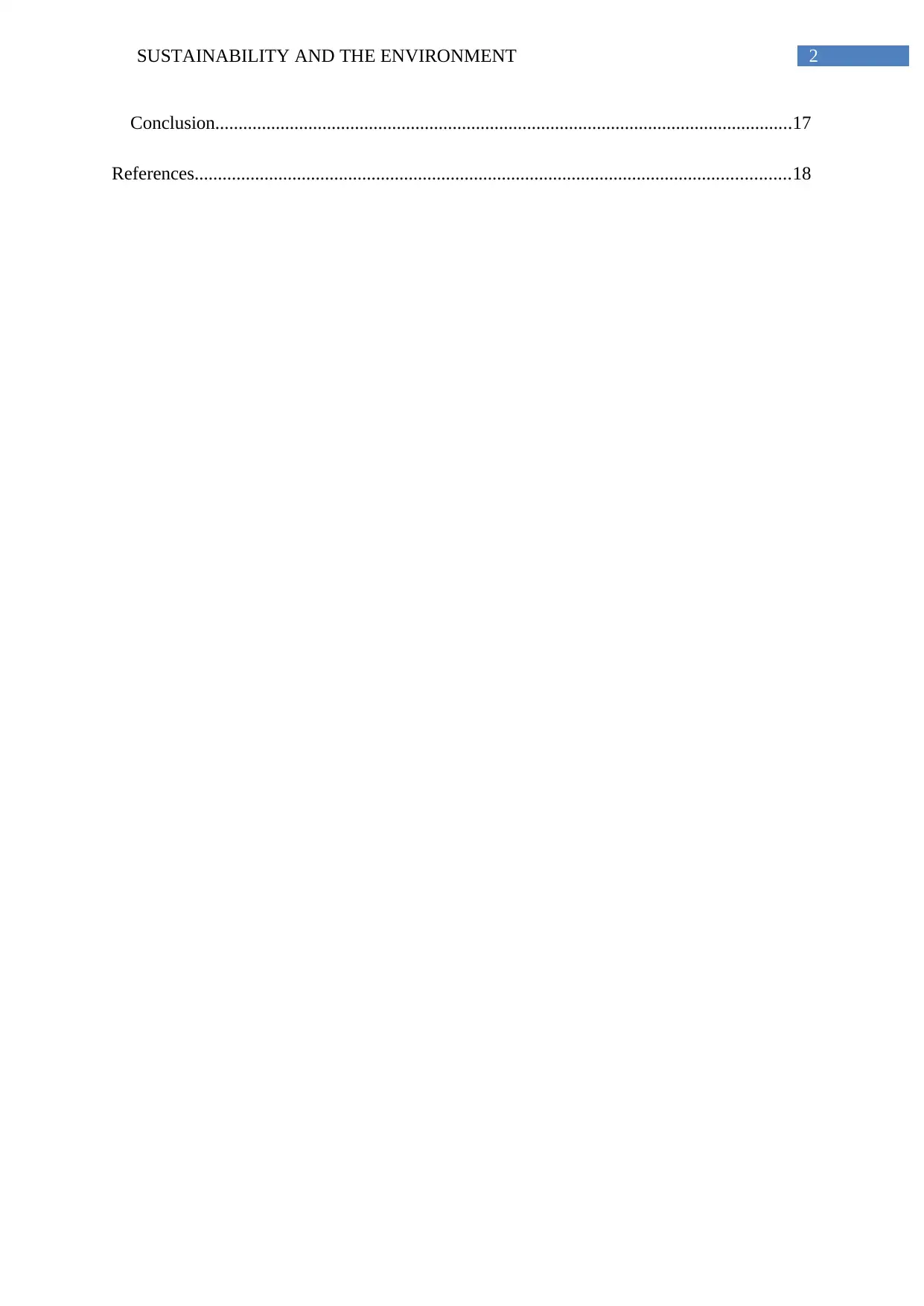
2SUSTAINABILITY AND THE ENVIRONMENT
Conclusion............................................................................................................................17
References................................................................................................................................18
Conclusion............................................................................................................................17
References................................................................................................................................18
⊘ This is a preview!⊘
Do you want full access?
Subscribe today to unlock all pages.

Trusted by 1+ million students worldwide
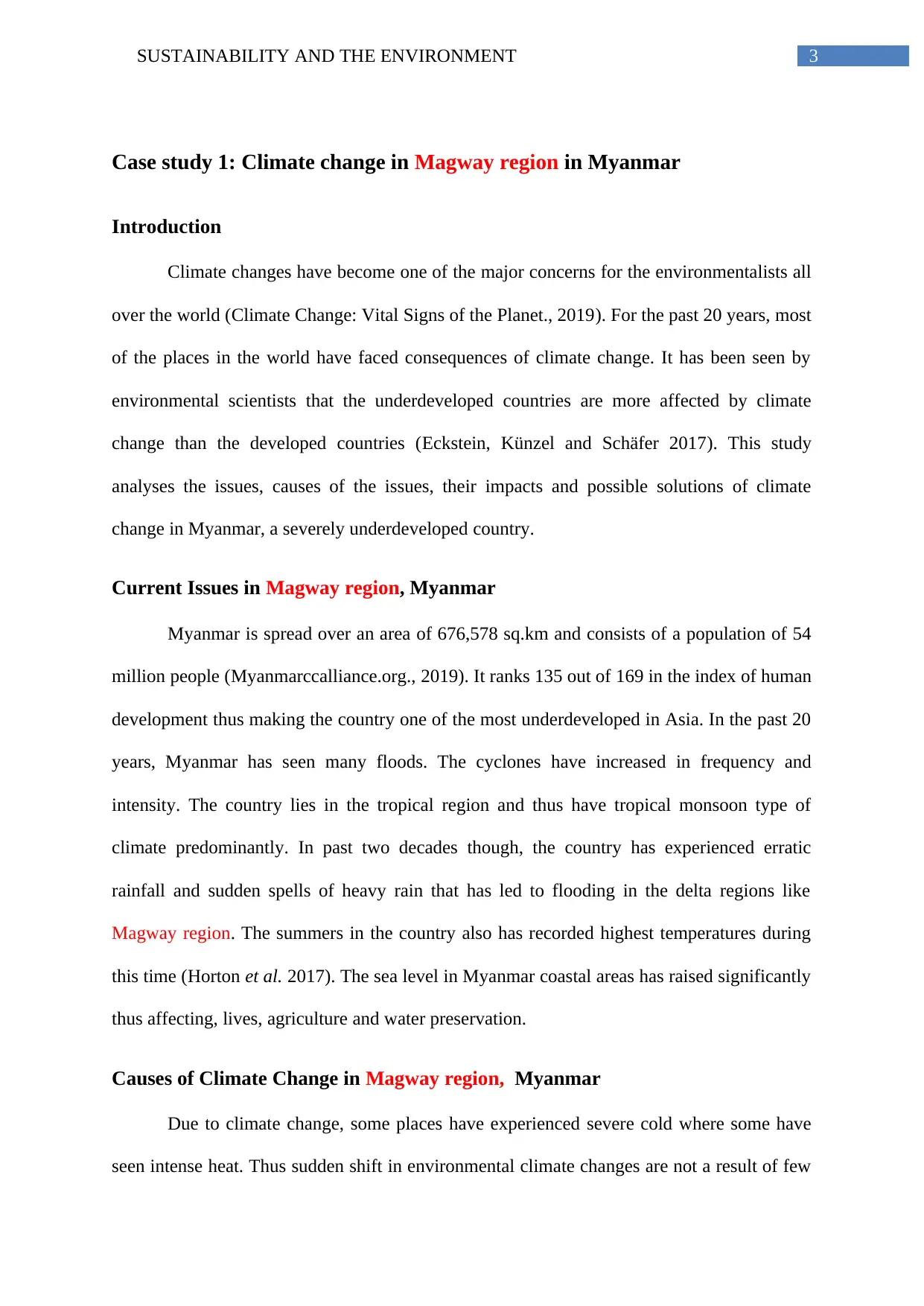
3SUSTAINABILITY AND THE ENVIRONMENT
Case study 1: Climate change in Magway region in Myanmar
Introduction
Climate changes have become one of the major concerns for the environmentalists all
over the world (Climate Change: Vital Signs of the Planet., 2019). For the past 20 years, most
of the places in the world have faced consequences of climate change. It has been seen by
environmental scientists that the underdeveloped countries are more affected by climate
change than the developed countries (Eckstein, Künzel and Schäfer 2017). This study
analyses the issues, causes of the issues, their impacts and possible solutions of climate
change in Myanmar, a severely underdeveloped country.
Current Issues in Magway region, Myanmar
Myanmar is spread over an area of 676,578 sq.km and consists of a population of 54
million people (Myanmarccalliance.org., 2019). It ranks 135 out of 169 in the index of human
development thus making the country one of the most underdeveloped in Asia. In the past 20
years, Myanmar has seen many floods. The cyclones have increased in frequency and
intensity. The country lies in the tropical region and thus have tropical monsoon type of
climate predominantly. In past two decades though, the country has experienced erratic
rainfall and sudden spells of heavy rain that has led to flooding in the delta regions like
Magway region. The summers in the country also has recorded highest temperatures during
this time (Horton et al. 2017). The sea level in Myanmar coastal areas has raised significantly
thus affecting, lives, agriculture and water preservation.
Causes of Climate Change in Magway region, Myanmar
Due to climate change, some places have experienced severe cold where some have
seen intense heat. Thus sudden shift in environmental climate changes are not a result of few
Case study 1: Climate change in Magway region in Myanmar
Introduction
Climate changes have become one of the major concerns for the environmentalists all
over the world (Climate Change: Vital Signs of the Planet., 2019). For the past 20 years, most
of the places in the world have faced consequences of climate change. It has been seen by
environmental scientists that the underdeveloped countries are more affected by climate
change than the developed countries (Eckstein, Künzel and Schäfer 2017). This study
analyses the issues, causes of the issues, their impacts and possible solutions of climate
change in Myanmar, a severely underdeveloped country.
Current Issues in Magway region, Myanmar
Myanmar is spread over an area of 676,578 sq.km and consists of a population of 54
million people (Myanmarccalliance.org., 2019). It ranks 135 out of 169 in the index of human
development thus making the country one of the most underdeveloped in Asia. In the past 20
years, Myanmar has seen many floods. The cyclones have increased in frequency and
intensity. The country lies in the tropical region and thus have tropical monsoon type of
climate predominantly. In past two decades though, the country has experienced erratic
rainfall and sudden spells of heavy rain that has led to flooding in the delta regions like
Magway region. The summers in the country also has recorded highest temperatures during
this time (Horton et al. 2017). The sea level in Myanmar coastal areas has raised significantly
thus affecting, lives, agriculture and water preservation.
Causes of Climate Change in Magway region, Myanmar
Due to climate change, some places have experienced severe cold where some have
seen intense heat. Thus sudden shift in environmental climate changes are not a result of few
Paraphrase This Document
Need a fresh take? Get an instant paraphrase of this document with our AI Paraphraser
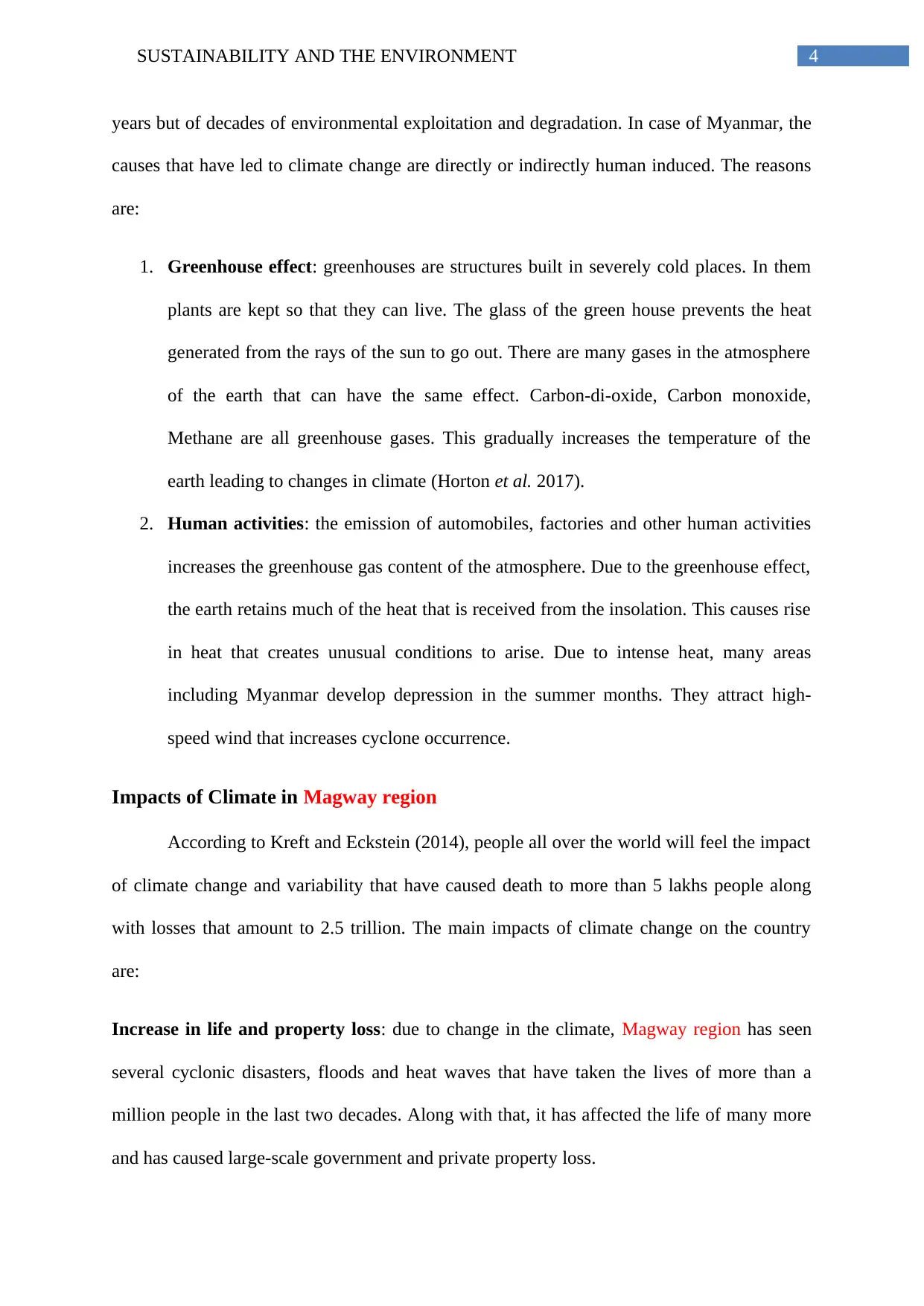
4SUSTAINABILITY AND THE ENVIRONMENT
years but of decades of environmental exploitation and degradation. In case of Myanmar, the
causes that have led to climate change are directly or indirectly human induced. The reasons
are:
1. Greenhouse effect: greenhouses are structures built in severely cold places. In them
plants are kept so that they can live. The glass of the green house prevents the heat
generated from the rays of the sun to go out. There are many gases in the atmosphere
of the earth that can have the same effect. Carbon-di-oxide, Carbon monoxide,
Methane are all greenhouse gases. This gradually increases the temperature of the
earth leading to changes in climate (Horton et al. 2017).
2. Human activities: the emission of automobiles, factories and other human activities
increases the greenhouse gas content of the atmosphere. Due to the greenhouse effect,
the earth retains much of the heat that is received from the insolation. This causes rise
in heat that creates unusual conditions to arise. Due to intense heat, many areas
including Myanmar develop depression in the summer months. They attract high-
speed wind that increases cyclone occurrence.
Impacts of Climate in Magway region
According to Kreft and Eckstein (2014), people all over the world will feel the impact
of climate change and variability that have caused death to more than 5 lakhs people along
with losses that amount to 2.5 trillion. The main impacts of climate change on the country
are:
Increase in life and property loss: due to change in the climate, Magway region has seen
several cyclonic disasters, floods and heat waves that have taken the lives of more than a
million people in the last two decades. Along with that, it has affected the life of many more
and has caused large-scale government and private property loss.
years but of decades of environmental exploitation and degradation. In case of Myanmar, the
causes that have led to climate change are directly or indirectly human induced. The reasons
are:
1. Greenhouse effect: greenhouses are structures built in severely cold places. In them
plants are kept so that they can live. The glass of the green house prevents the heat
generated from the rays of the sun to go out. There are many gases in the atmosphere
of the earth that can have the same effect. Carbon-di-oxide, Carbon monoxide,
Methane are all greenhouse gases. This gradually increases the temperature of the
earth leading to changes in climate (Horton et al. 2017).
2. Human activities: the emission of automobiles, factories and other human activities
increases the greenhouse gas content of the atmosphere. Due to the greenhouse effect,
the earth retains much of the heat that is received from the insolation. This causes rise
in heat that creates unusual conditions to arise. Due to intense heat, many areas
including Myanmar develop depression in the summer months. They attract high-
speed wind that increases cyclone occurrence.
Impacts of Climate in Magway region
According to Kreft and Eckstein (2014), people all over the world will feel the impact
of climate change and variability that have caused death to more than 5 lakhs people along
with losses that amount to 2.5 trillion. The main impacts of climate change on the country
are:
Increase in life and property loss: due to change in the climate, Magway region has seen
several cyclonic disasters, floods and heat waves that have taken the lives of more than a
million people in the last two decades. Along with that, it has affected the life of many more
and has caused large-scale government and private property loss.
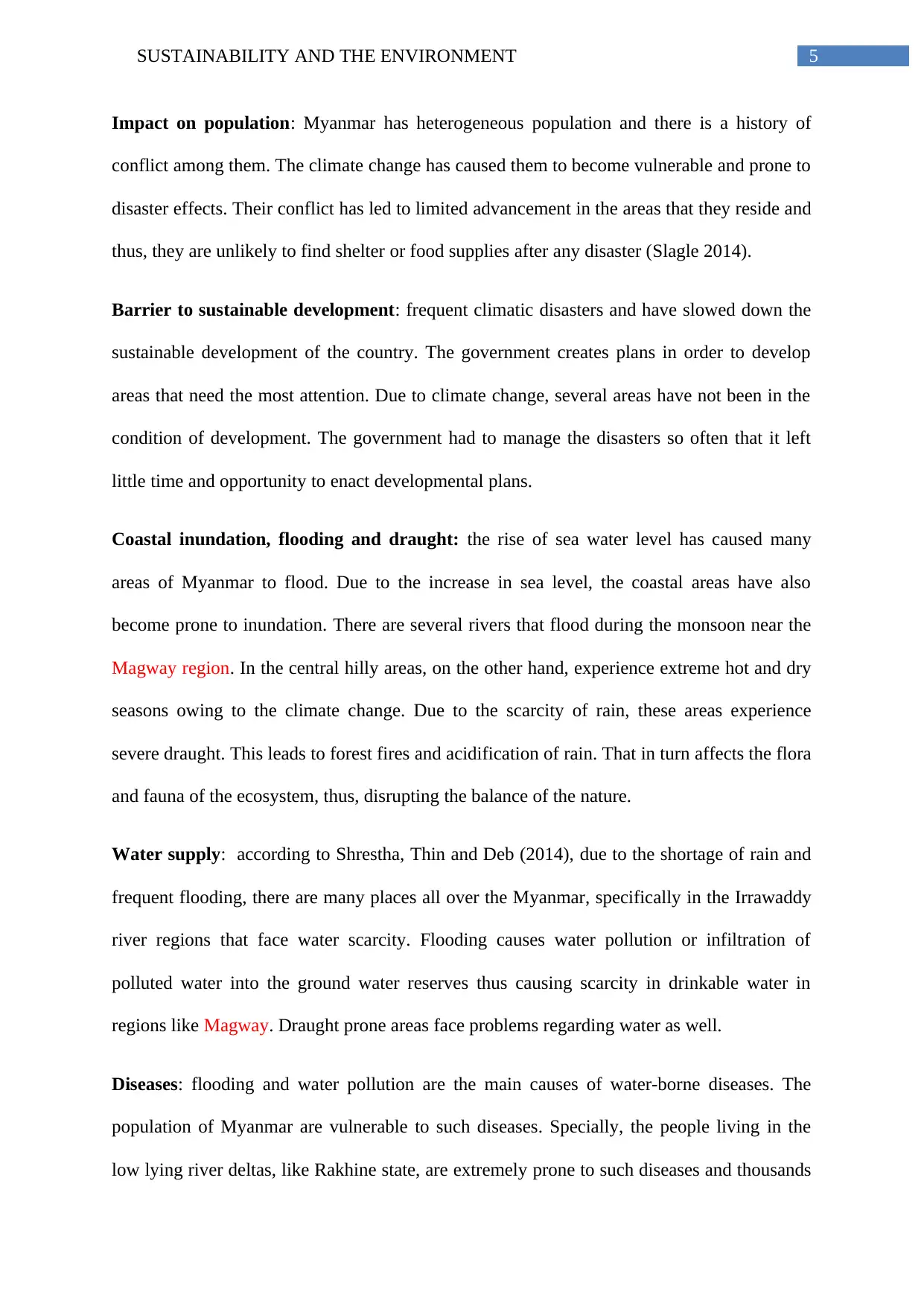
5SUSTAINABILITY AND THE ENVIRONMENT
Impact on population: Myanmar has heterogeneous population and there is a history of
conflict among them. The climate change has caused them to become vulnerable and prone to
disaster effects. Their conflict has led to limited advancement in the areas that they reside and
thus, they are unlikely to find shelter or food supplies after any disaster (Slagle 2014).
Barrier to sustainable development: frequent climatic disasters and have slowed down the
sustainable development of the country. The government creates plans in order to develop
areas that need the most attention. Due to climate change, several areas have not been in the
condition of development. The government had to manage the disasters so often that it left
little time and opportunity to enact developmental plans.
Coastal inundation, flooding and draught: the rise of sea water level has caused many
areas of Myanmar to flood. Due to the increase in sea level, the coastal areas have also
become prone to inundation. There are several rivers that flood during the monsoon near the
Magway region. In the central hilly areas, on the other hand, experience extreme hot and dry
seasons owing to the climate change. Due to the scarcity of rain, these areas experience
severe draught. This leads to forest fires and acidification of rain. That in turn affects the flora
and fauna of the ecosystem, thus, disrupting the balance of the nature.
Water supply: according to Shrestha, Thin and Deb (2014), due to the shortage of rain and
frequent flooding, there are many places all over the Myanmar, specifically in the Irrawaddy
river regions that face water scarcity. Flooding causes water pollution or infiltration of
polluted water into the ground water reserves thus causing scarcity in drinkable water in
regions like Magway. Draught prone areas face problems regarding water as well.
Diseases: flooding and water pollution are the main causes of water-borne diseases. The
population of Myanmar are vulnerable to such diseases. Specially, the people living in the
low lying river deltas, like Rakhine state, are extremely prone to such diseases and thousands
Impact on population: Myanmar has heterogeneous population and there is a history of
conflict among them. The climate change has caused them to become vulnerable and prone to
disaster effects. Their conflict has led to limited advancement in the areas that they reside and
thus, they are unlikely to find shelter or food supplies after any disaster (Slagle 2014).
Barrier to sustainable development: frequent climatic disasters and have slowed down the
sustainable development of the country. The government creates plans in order to develop
areas that need the most attention. Due to climate change, several areas have not been in the
condition of development. The government had to manage the disasters so often that it left
little time and opportunity to enact developmental plans.
Coastal inundation, flooding and draught: the rise of sea water level has caused many
areas of Myanmar to flood. Due to the increase in sea level, the coastal areas have also
become prone to inundation. There are several rivers that flood during the monsoon near the
Magway region. In the central hilly areas, on the other hand, experience extreme hot and dry
seasons owing to the climate change. Due to the scarcity of rain, these areas experience
severe draught. This leads to forest fires and acidification of rain. That in turn affects the flora
and fauna of the ecosystem, thus, disrupting the balance of the nature.
Water supply: according to Shrestha, Thin and Deb (2014), due to the shortage of rain and
frequent flooding, there are many places all over the Myanmar, specifically in the Irrawaddy
river regions that face water scarcity. Flooding causes water pollution or infiltration of
polluted water into the ground water reserves thus causing scarcity in drinkable water in
regions like Magway. Draught prone areas face problems regarding water as well.
Diseases: flooding and water pollution are the main causes of water-borne diseases. The
population of Myanmar are vulnerable to such diseases. Specially, the people living in the
low lying river deltas, like Rakhine state, are extremely prone to such diseases and thousands
⊘ This is a preview!⊘
Do you want full access?
Subscribe today to unlock all pages.

Trusted by 1+ million students worldwide
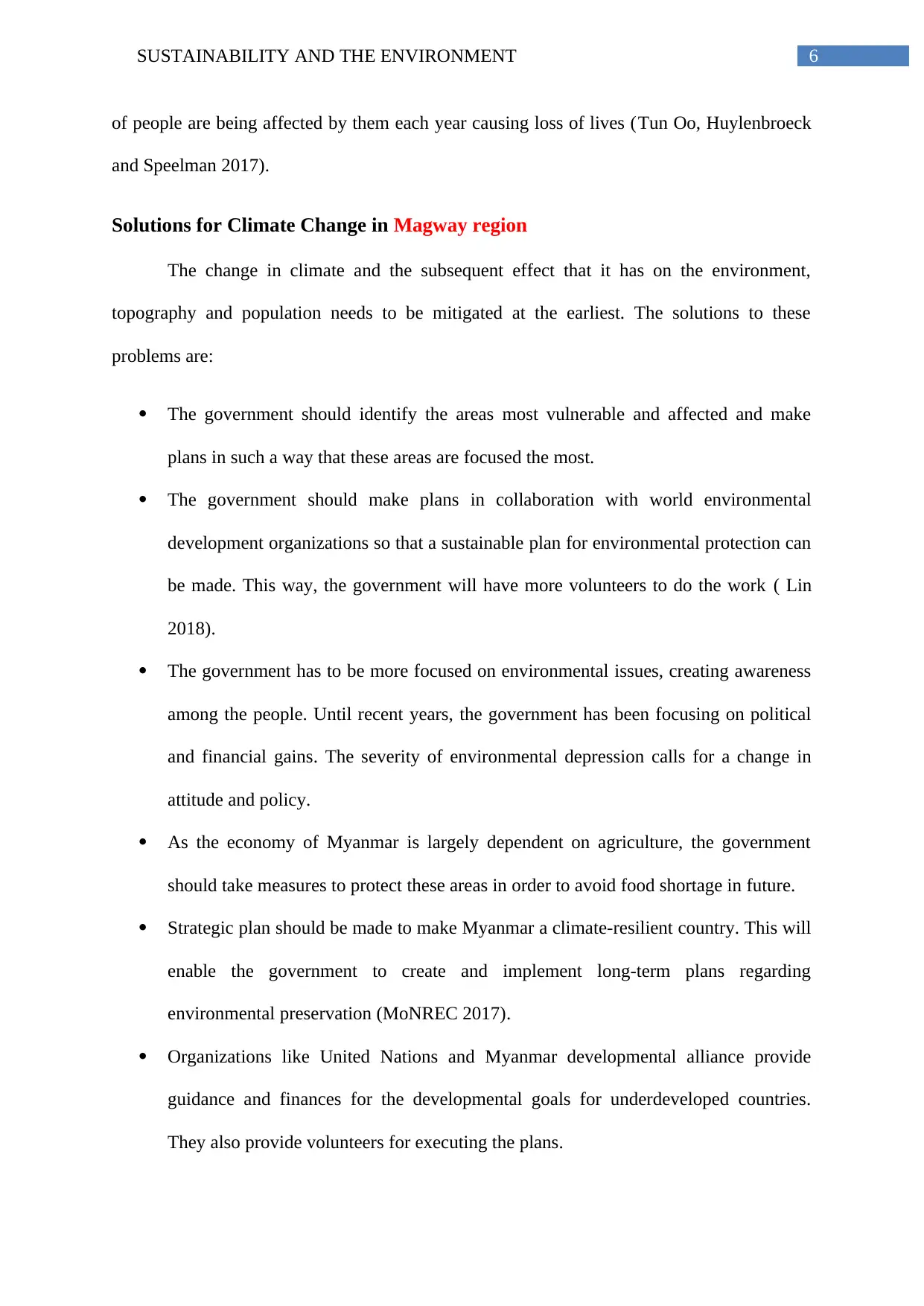
6SUSTAINABILITY AND THE ENVIRONMENT
of people are being affected by them each year causing loss of lives (Tun Oo, Huylenbroeck
and Speelman 2017).
Solutions for Climate Change in Magway region
The change in climate and the subsequent effect that it has on the environment,
topography and population needs to be mitigated at the earliest. The solutions to these
problems are:
The government should identify the areas most vulnerable and affected and make
plans in such a way that these areas are focused the most.
The government should make plans in collaboration with world environmental
development organizations so that a sustainable plan for environmental protection can
be made. This way, the government will have more volunteers to do the work ( Lin
2018).
The government has to be more focused on environmental issues, creating awareness
among the people. Until recent years, the government has been focusing on political
and financial gains. The severity of environmental depression calls for a change in
attitude and policy.
As the economy of Myanmar is largely dependent on agriculture, the government
should take measures to protect these areas in order to avoid food shortage in future.
Strategic plan should be made to make Myanmar a climate-resilient country. This will
enable the government to create and implement long-term plans regarding
environmental preservation (MoNREC 2017).
Organizations like United Nations and Myanmar developmental alliance provide
guidance and finances for the developmental goals for underdeveloped countries.
They also provide volunteers for executing the plans.
of people are being affected by them each year causing loss of lives (Tun Oo, Huylenbroeck
and Speelman 2017).
Solutions for Climate Change in Magway region
The change in climate and the subsequent effect that it has on the environment,
topography and population needs to be mitigated at the earliest. The solutions to these
problems are:
The government should identify the areas most vulnerable and affected and make
plans in such a way that these areas are focused the most.
The government should make plans in collaboration with world environmental
development organizations so that a sustainable plan for environmental protection can
be made. This way, the government will have more volunteers to do the work ( Lin
2018).
The government has to be more focused on environmental issues, creating awareness
among the people. Until recent years, the government has been focusing on political
and financial gains. The severity of environmental depression calls for a change in
attitude and policy.
As the economy of Myanmar is largely dependent on agriculture, the government
should take measures to protect these areas in order to avoid food shortage in future.
Strategic plan should be made to make Myanmar a climate-resilient country. This will
enable the government to create and implement long-term plans regarding
environmental preservation (MoNREC 2017).
Organizations like United Nations and Myanmar developmental alliance provide
guidance and finances for the developmental goals for underdeveloped countries.
They also provide volunteers for executing the plans.
Paraphrase This Document
Need a fresh take? Get an instant paraphrase of this document with our AI Paraphraser
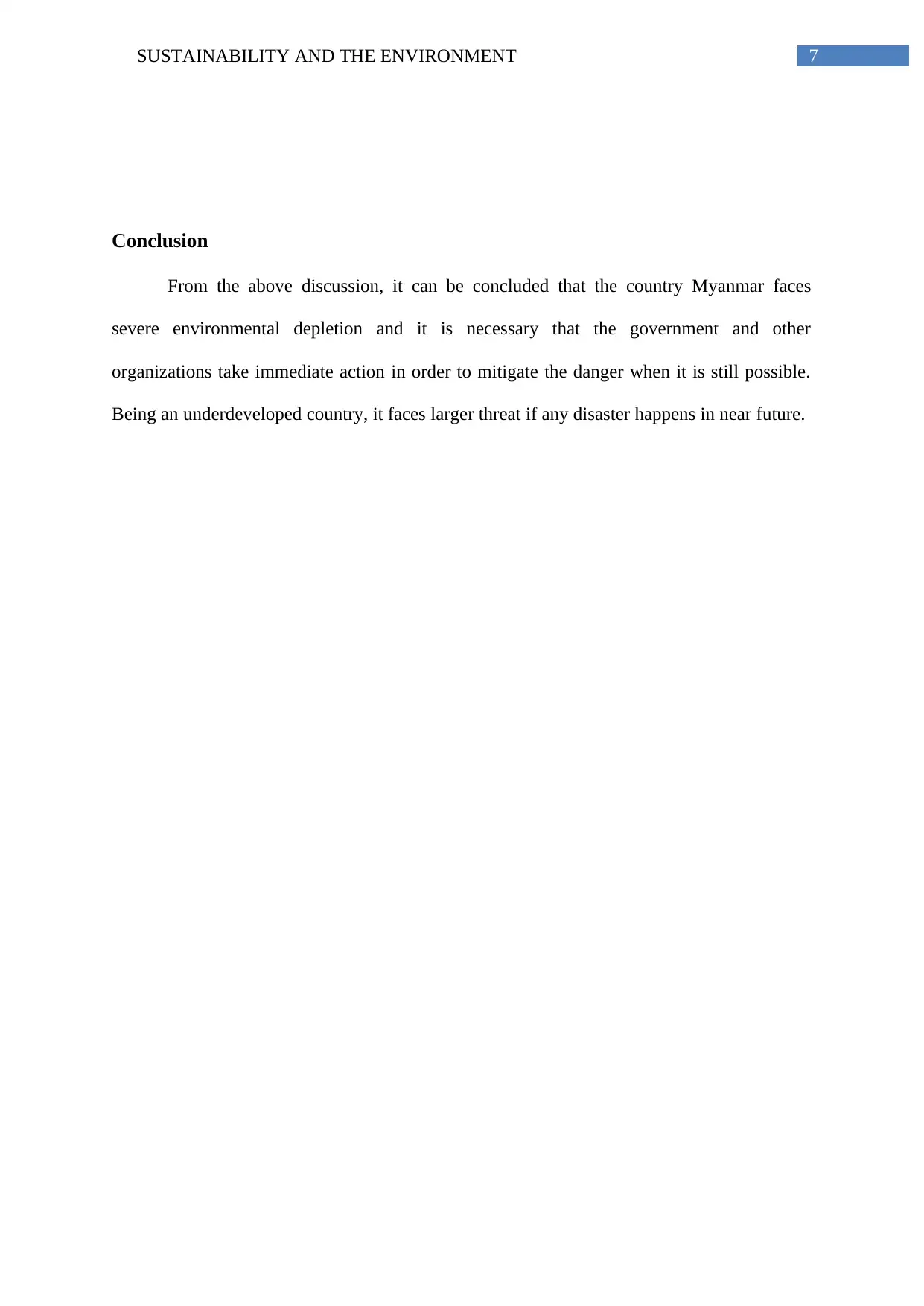
7SUSTAINABILITY AND THE ENVIRONMENT
Conclusion
From the above discussion, it can be concluded that the country Myanmar faces
severe environmental depletion and it is necessary that the government and other
organizations take immediate action in order to mitigate the danger when it is still possible.
Being an underdeveloped country, it faces larger threat if any disaster happens in near future.
Conclusion
From the above discussion, it can be concluded that the country Myanmar faces
severe environmental depletion and it is necessary that the government and other
organizations take immediate action in order to mitigate the danger when it is still possible.
Being an underdeveloped country, it faces larger threat if any disaster happens in near future.
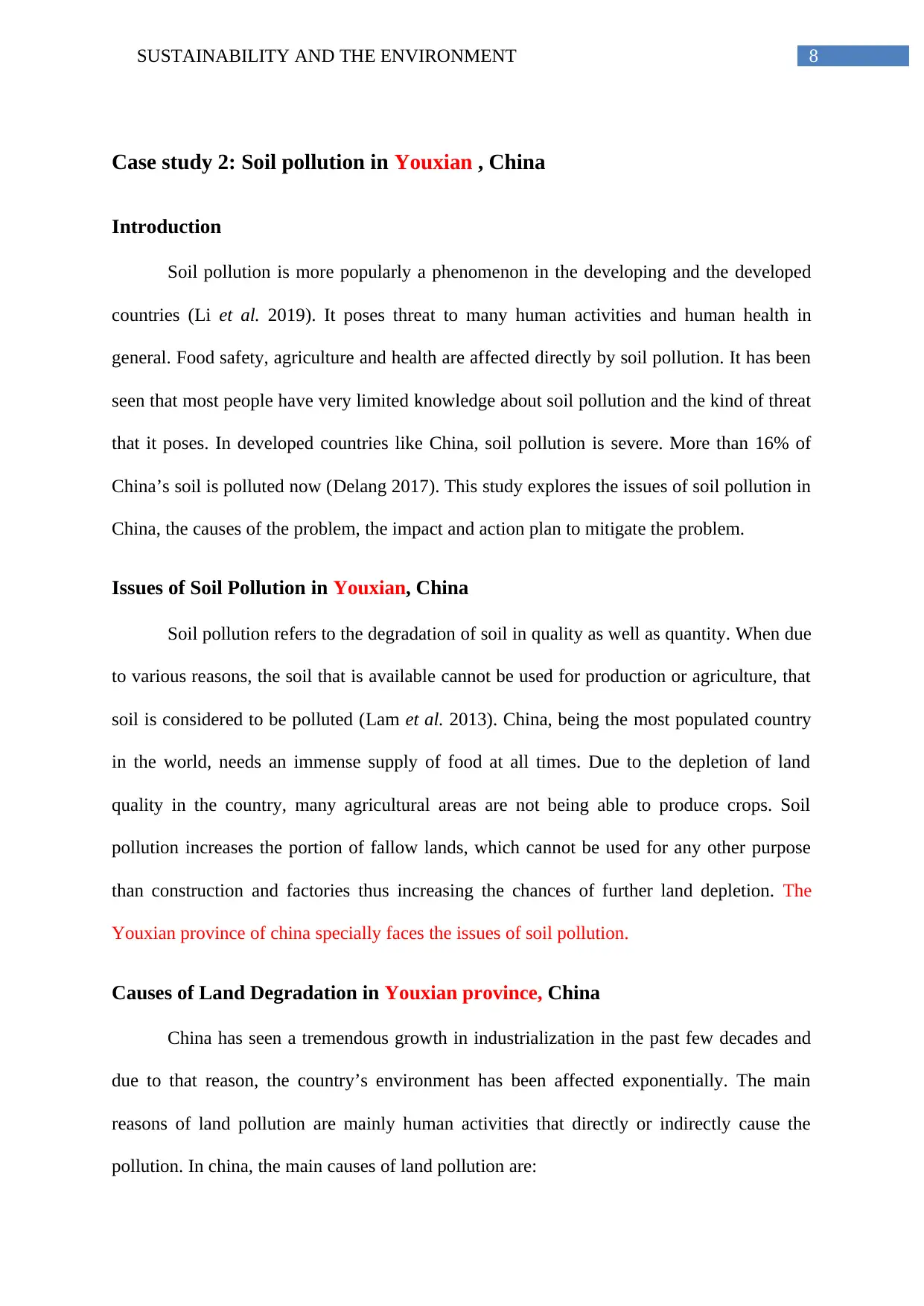
8SUSTAINABILITY AND THE ENVIRONMENT
Case study 2: Soil pollution in Youxian , China
Introduction
Soil pollution is more popularly a phenomenon in the developing and the developed
countries (Li et al. 2019). It poses threat to many human activities and human health in
general. Food safety, agriculture and health are affected directly by soil pollution. It has been
seen that most people have very limited knowledge about soil pollution and the kind of threat
that it poses. In developed countries like China, soil pollution is severe. More than 16% of
China’s soil is polluted now (Delang 2017). This study explores the issues of soil pollution in
China, the causes of the problem, the impact and action plan to mitigate the problem.
Issues of Soil Pollution in Youxian, China
Soil pollution refers to the degradation of soil in quality as well as quantity. When due
to various reasons, the soil that is available cannot be used for production or agriculture, that
soil is considered to be polluted (Lam et al. 2013). China, being the most populated country
in the world, needs an immense supply of food at all times. Due to the depletion of land
quality in the country, many agricultural areas are not being able to produce crops. Soil
pollution increases the portion of fallow lands, which cannot be used for any other purpose
than construction and factories thus increasing the chances of further land depletion. The
Youxian province of china specially faces the issues of soil pollution.
Causes of Land Degradation in Youxian province, China
China has seen a tremendous growth in industrialization in the past few decades and
due to that reason, the country’s environment has been affected exponentially. The main
reasons of land pollution are mainly human activities that directly or indirectly cause the
pollution. In china, the main causes of land pollution are:
Case study 2: Soil pollution in Youxian , China
Introduction
Soil pollution is more popularly a phenomenon in the developing and the developed
countries (Li et al. 2019). It poses threat to many human activities and human health in
general. Food safety, agriculture and health are affected directly by soil pollution. It has been
seen that most people have very limited knowledge about soil pollution and the kind of threat
that it poses. In developed countries like China, soil pollution is severe. More than 16% of
China’s soil is polluted now (Delang 2017). This study explores the issues of soil pollution in
China, the causes of the problem, the impact and action plan to mitigate the problem.
Issues of Soil Pollution in Youxian, China
Soil pollution refers to the degradation of soil in quality as well as quantity. When due
to various reasons, the soil that is available cannot be used for production or agriculture, that
soil is considered to be polluted (Lam et al. 2013). China, being the most populated country
in the world, needs an immense supply of food at all times. Due to the depletion of land
quality in the country, many agricultural areas are not being able to produce crops. Soil
pollution increases the portion of fallow lands, which cannot be used for any other purpose
than construction and factories thus increasing the chances of further land depletion. The
Youxian province of china specially faces the issues of soil pollution.
Causes of Land Degradation in Youxian province, China
China has seen a tremendous growth in industrialization in the past few decades and
due to that reason, the country’s environment has been affected exponentially. The main
reasons of land pollution are mainly human activities that directly or indirectly cause the
pollution. In china, the main causes of land pollution are:
⊘ This is a preview!⊘
Do you want full access?
Subscribe today to unlock all pages.

Trusted by 1+ million students worldwide
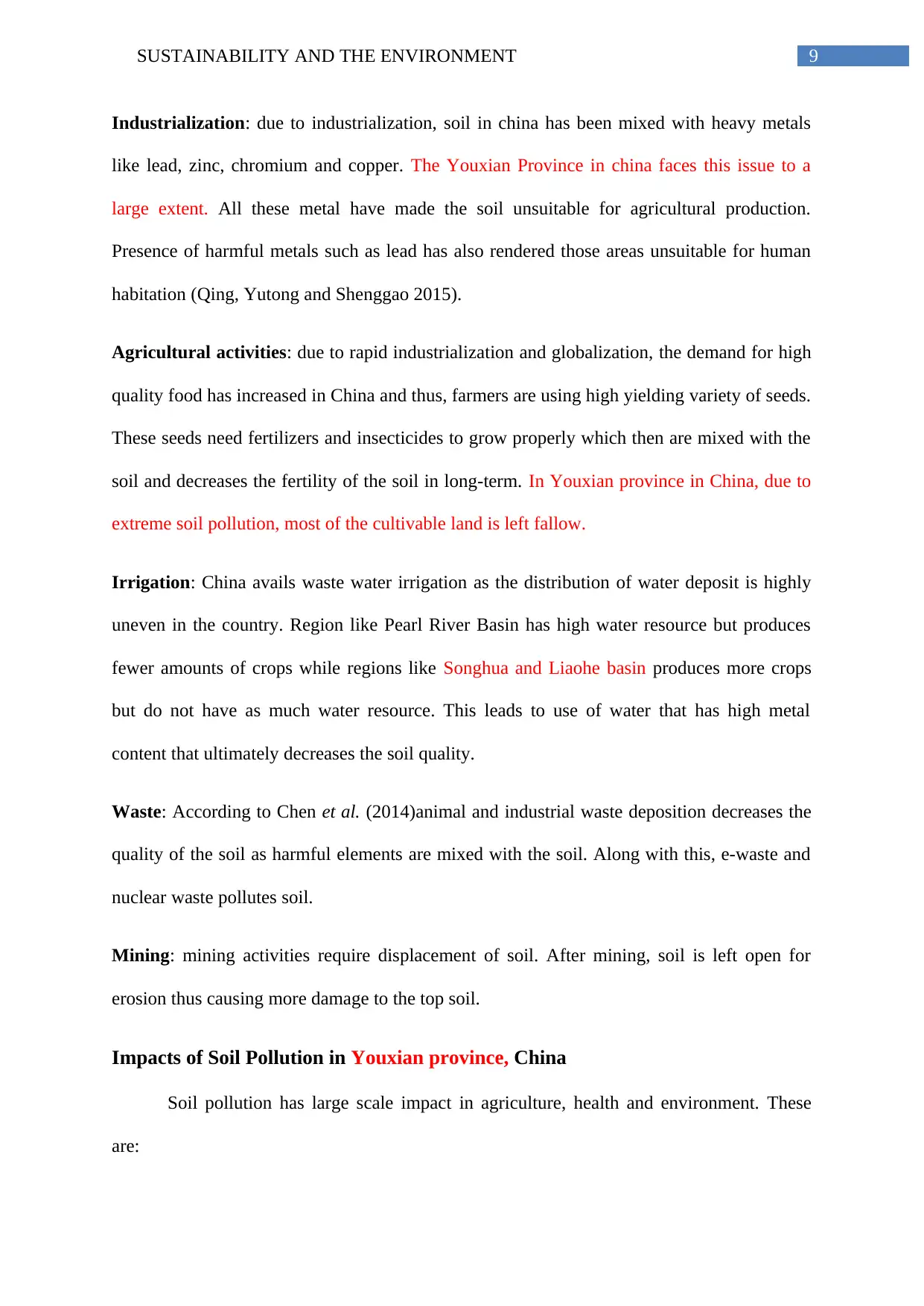
9SUSTAINABILITY AND THE ENVIRONMENT
Industrialization: due to industrialization, soil in china has been mixed with heavy metals
like lead, zinc, chromium and copper. The Youxian Province in china faces this issue to a
large extent. All these metal have made the soil unsuitable for agricultural production.
Presence of harmful metals such as lead has also rendered those areas unsuitable for human
habitation (Qing, Yutong and Shenggao 2015).
Agricultural activities: due to rapid industrialization and globalization, the demand for high
quality food has increased in China and thus, farmers are using high yielding variety of seeds.
These seeds need fertilizers and insecticides to grow properly which then are mixed with the
soil and decreases the fertility of the soil in long-term. In Youxian province in China, due to
extreme soil pollution, most of the cultivable land is left fallow.
Irrigation: China avails waste water irrigation as the distribution of water deposit is highly
uneven in the country. Region like Pearl River Basin has high water resource but produces
fewer amounts of crops while regions like Songhua and Liaohe basin produces more crops
but do not have as much water resource. This leads to use of water that has high metal
content that ultimately decreases the soil quality.
Waste: According to Chen et al. (2014)animal and industrial waste deposition decreases the
quality of the soil as harmful elements are mixed with the soil. Along with this, e-waste and
nuclear waste pollutes soil.
Mining: mining activities require displacement of soil. After mining, soil is left open for
erosion thus causing more damage to the top soil.
Impacts of Soil Pollution in Youxian province, China
Soil pollution has large scale impact in agriculture, health and environment. These
are:
Industrialization: due to industrialization, soil in china has been mixed with heavy metals
like lead, zinc, chromium and copper. The Youxian Province in china faces this issue to a
large extent. All these metal have made the soil unsuitable for agricultural production.
Presence of harmful metals such as lead has also rendered those areas unsuitable for human
habitation (Qing, Yutong and Shenggao 2015).
Agricultural activities: due to rapid industrialization and globalization, the demand for high
quality food has increased in China and thus, farmers are using high yielding variety of seeds.
These seeds need fertilizers and insecticides to grow properly which then are mixed with the
soil and decreases the fertility of the soil in long-term. In Youxian province in China, due to
extreme soil pollution, most of the cultivable land is left fallow.
Irrigation: China avails waste water irrigation as the distribution of water deposit is highly
uneven in the country. Region like Pearl River Basin has high water resource but produces
fewer amounts of crops while regions like Songhua and Liaohe basin produces more crops
but do not have as much water resource. This leads to use of water that has high metal
content that ultimately decreases the soil quality.
Waste: According to Chen et al. (2014)animal and industrial waste deposition decreases the
quality of the soil as harmful elements are mixed with the soil. Along with this, e-waste and
nuclear waste pollutes soil.
Mining: mining activities require displacement of soil. After mining, soil is left open for
erosion thus causing more damage to the top soil.
Impacts of Soil Pollution in Youxian province, China
Soil pollution has large scale impact in agriculture, health and environment. These
are:
Paraphrase This Document
Need a fresh take? Get an instant paraphrase of this document with our AI Paraphraser
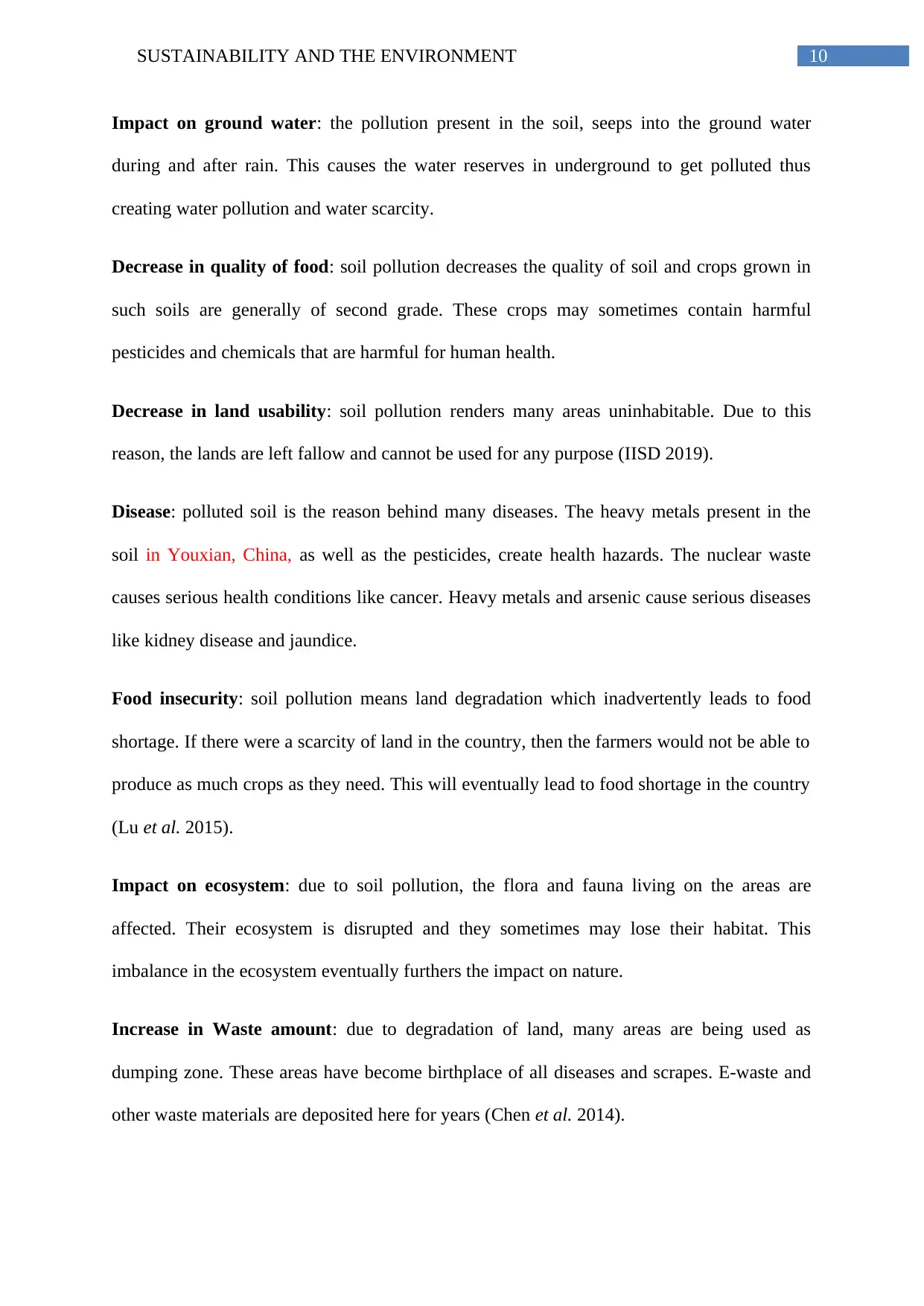
10SUSTAINABILITY AND THE ENVIRONMENT
Impact on ground water: the pollution present in the soil, seeps into the ground water
during and after rain. This causes the water reserves in underground to get polluted thus
creating water pollution and water scarcity.
Decrease in quality of food: soil pollution decreases the quality of soil and crops grown in
such soils are generally of second grade. These crops may sometimes contain harmful
pesticides and chemicals that are harmful for human health.
Decrease in land usability: soil pollution renders many areas uninhabitable. Due to this
reason, the lands are left fallow and cannot be used for any purpose (IISD 2019).
Disease: polluted soil is the reason behind many diseases. The heavy metals present in the
soil in Youxian, China, as well as the pesticides, create health hazards. The nuclear waste
causes serious health conditions like cancer. Heavy metals and arsenic cause serious diseases
like kidney disease and jaundice.
Food insecurity: soil pollution means land degradation which inadvertently leads to food
shortage. If there were a scarcity of land in the country, then the farmers would not be able to
produce as much crops as they need. This will eventually lead to food shortage in the country
(Lu et al. 2015).
Impact on ecosystem: due to soil pollution, the flora and fauna living on the areas are
affected. Their ecosystem is disrupted and they sometimes may lose their habitat. This
imbalance in the ecosystem eventually furthers the impact on nature.
Increase in Waste amount: due to degradation of land, many areas are being used as
dumping zone. These areas have become birthplace of all diseases and scrapes. E-waste and
other waste materials are deposited here for years (Chen et al. 2014).
Impact on ground water: the pollution present in the soil, seeps into the ground water
during and after rain. This causes the water reserves in underground to get polluted thus
creating water pollution and water scarcity.
Decrease in quality of food: soil pollution decreases the quality of soil and crops grown in
such soils are generally of second grade. These crops may sometimes contain harmful
pesticides and chemicals that are harmful for human health.
Decrease in land usability: soil pollution renders many areas uninhabitable. Due to this
reason, the lands are left fallow and cannot be used for any purpose (IISD 2019).
Disease: polluted soil is the reason behind many diseases. The heavy metals present in the
soil in Youxian, China, as well as the pesticides, create health hazards. The nuclear waste
causes serious health conditions like cancer. Heavy metals and arsenic cause serious diseases
like kidney disease and jaundice.
Food insecurity: soil pollution means land degradation which inadvertently leads to food
shortage. If there were a scarcity of land in the country, then the farmers would not be able to
produce as much crops as they need. This will eventually lead to food shortage in the country
(Lu et al. 2015).
Impact on ecosystem: due to soil pollution, the flora and fauna living on the areas are
affected. Their ecosystem is disrupted and they sometimes may lose their habitat. This
imbalance in the ecosystem eventually furthers the impact on nature.
Increase in Waste amount: due to degradation of land, many areas are being used as
dumping zone. These areas have become birthplace of all diseases and scrapes. E-waste and
other waste materials are deposited here for years (Chen et al. 2014).
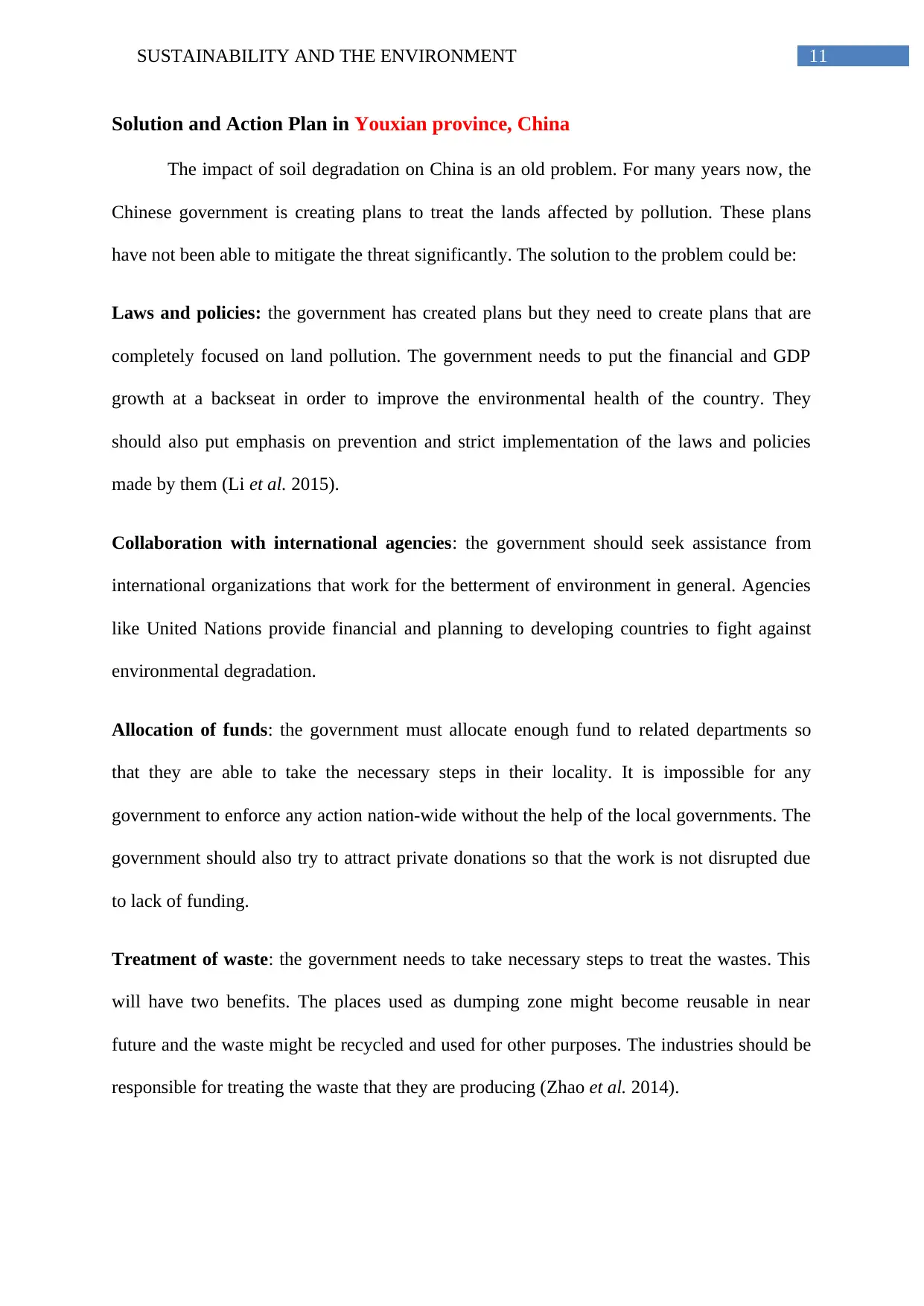
11SUSTAINABILITY AND THE ENVIRONMENT
Solution and Action Plan in Youxian province, China
The impact of soil degradation on China is an old problem. For many years now, the
Chinese government is creating plans to treat the lands affected by pollution. These plans
have not been able to mitigate the threat significantly. The solution to the problem could be:
Laws and policies: the government has created plans but they need to create plans that are
completely focused on land pollution. The government needs to put the financial and GDP
growth at a backseat in order to improve the environmental health of the country. They
should also put emphasis on prevention and strict implementation of the laws and policies
made by them (Li et al. 2015).
Collaboration with international agencies: the government should seek assistance from
international organizations that work for the betterment of environment in general. Agencies
like United Nations provide financial and planning to developing countries to fight against
environmental degradation.
Allocation of funds: the government must allocate enough fund to related departments so
that they are able to take the necessary steps in their locality. It is impossible for any
government to enforce any action nation-wide without the help of the local governments. The
government should also try to attract private donations so that the work is not disrupted due
to lack of funding.
Treatment of waste: the government needs to take necessary steps to treat the wastes. This
will have two benefits. The places used as dumping zone might become reusable in near
future and the waste might be recycled and used for other purposes. The industries should be
responsible for treating the waste that they are producing (Zhao et al. 2014).
Solution and Action Plan in Youxian province, China
The impact of soil degradation on China is an old problem. For many years now, the
Chinese government is creating plans to treat the lands affected by pollution. These plans
have not been able to mitigate the threat significantly. The solution to the problem could be:
Laws and policies: the government has created plans but they need to create plans that are
completely focused on land pollution. The government needs to put the financial and GDP
growth at a backseat in order to improve the environmental health of the country. They
should also put emphasis on prevention and strict implementation of the laws and policies
made by them (Li et al. 2015).
Collaboration with international agencies: the government should seek assistance from
international organizations that work for the betterment of environment in general. Agencies
like United Nations provide financial and planning to developing countries to fight against
environmental degradation.
Allocation of funds: the government must allocate enough fund to related departments so
that they are able to take the necessary steps in their locality. It is impossible for any
government to enforce any action nation-wide without the help of the local governments. The
government should also try to attract private donations so that the work is not disrupted due
to lack of funding.
Treatment of waste: the government needs to take necessary steps to treat the wastes. This
will have two benefits. The places used as dumping zone might become reusable in near
future and the waste might be recycled and used for other purposes. The industries should be
responsible for treating the waste that they are producing (Zhao et al. 2014).
⊘ This is a preview!⊘
Do you want full access?
Subscribe today to unlock all pages.

Trusted by 1+ million students worldwide
1 out of 22
Related Documents
Your All-in-One AI-Powered Toolkit for Academic Success.
+13062052269
info@desklib.com
Available 24*7 on WhatsApp / Email
![[object Object]](/_next/static/media/star-bottom.7253800d.svg)
Unlock your academic potential
Copyright © 2020–2025 A2Z Services. All Rights Reserved. Developed and managed by ZUCOL.





